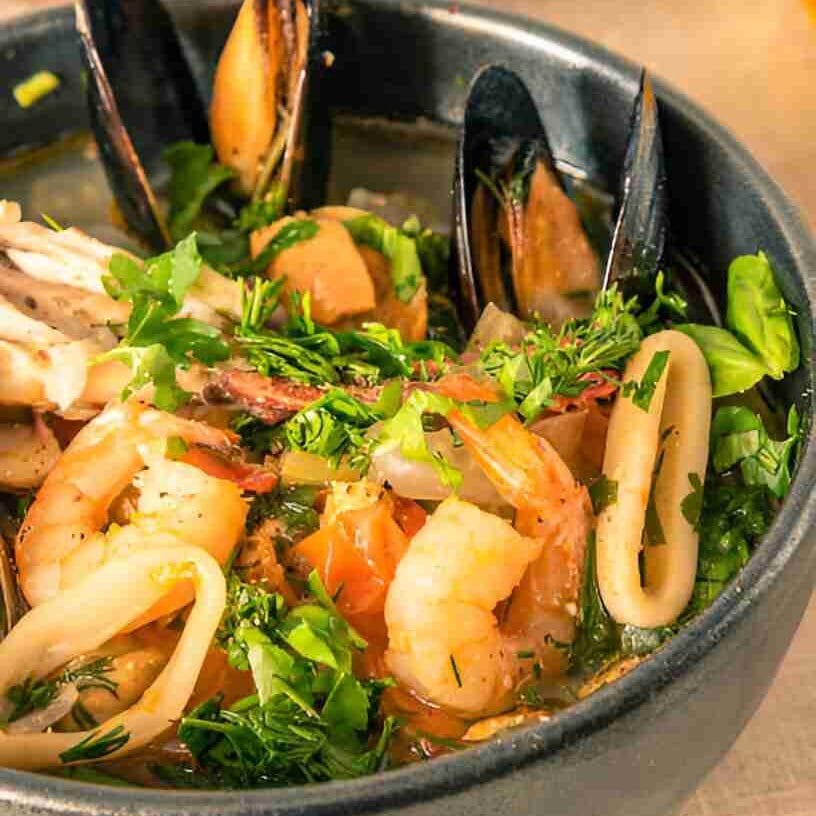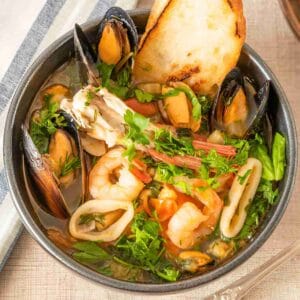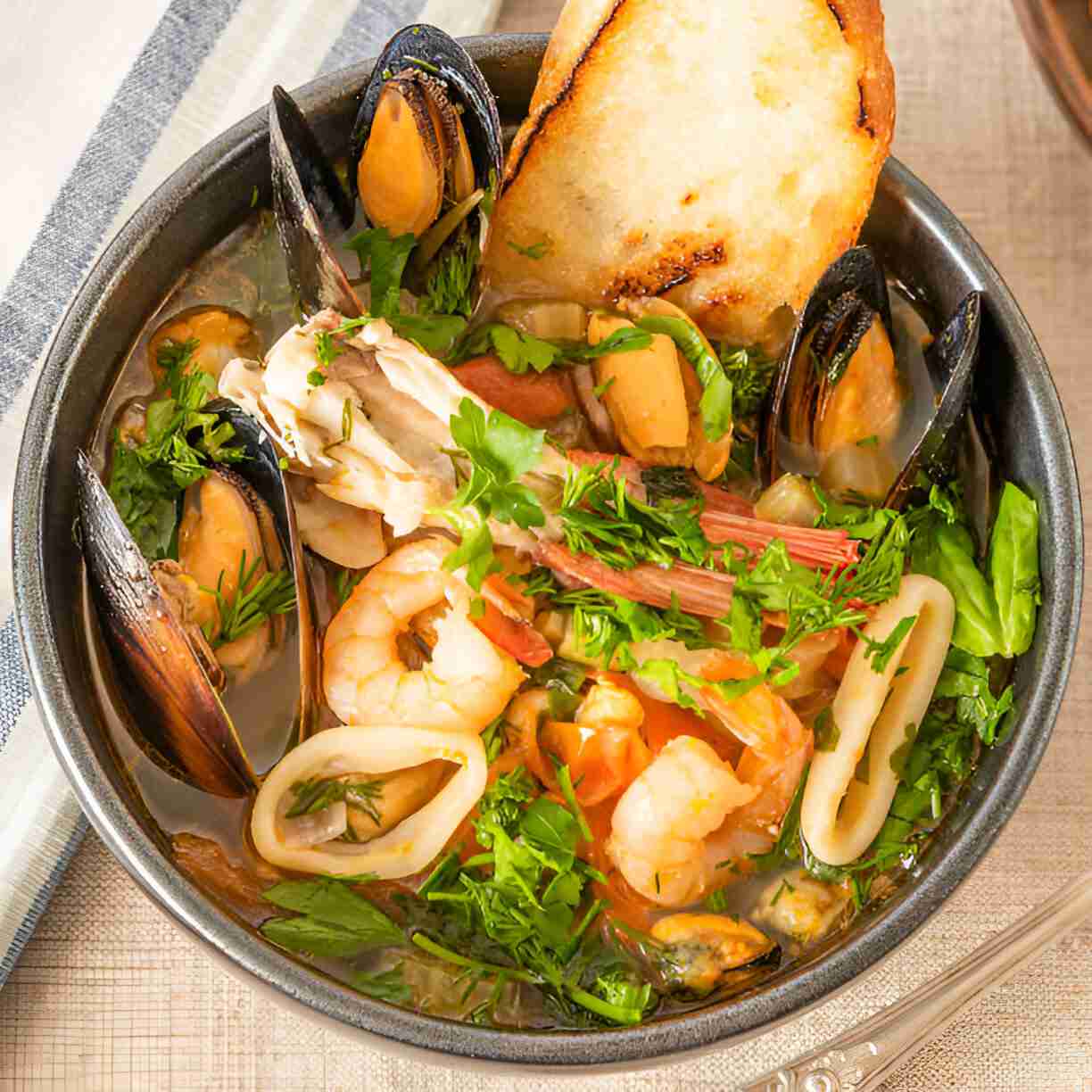Bouillabaisse is not just a dish; it’s an experience! This iconic Provençal seafood stew captures the essence of the Mediterranean with its rich flavors and vibrant ingredients. Perfect for a family gathering or a cozy evening at home, this recipe is sure to please everyone at the table. The blend of seafood and aromatic herbs creates a delightful symphony of taste that will have you coming back for more.

Why You’ll Love Bouillabaisse
Perfect for Families
One of the best parts about making Bouillabaisse is how it brings everyone together. As you simmer seafood and create a tasty broth, the enticing aroma fills your home, making it an irresistible invitation for family and friends. Involve your loved ones by having them help with the chopping and preparation. It’s not just a meal; it’s a bonding experience!
Nutritional Benefits
Bouillabaisse is not only delicious but also packed with health benefits. With an abundance of seafood, it’s a great source of lean protein, omega-3 fatty acids, and essential vitamins and minerals. Incorporating fresh vegetables, like fennel and tomatoes, adds fiber and nutrients, making this stew a balanced option for any meal.
Flexibility
The beauty of Bouillabaisse lies in its versatility. You can customize it to your taste preferences or dietary needs, making it both adaptable and budget-friendly. Whether you have shrimp, mussels, or any other seafood you want to use, feel free to mix and match. This dish allows creativity in the kitchen!
Essential Ingredients for the Recipe
Ingredients:
- For the Broth:
- 2 tbsp olive oil
- 1 fennel bulb, chopped
- 1 onion, diced
- 3 garlic cloves, minced
- 1 orange peel (strip)
- 1 lb ripe tomatoes, chopped
- 1 tsp saffron threads
- 3 cups fish stock
- 1 cup white wine
- 1 bouquet garni (thyme, bay leaf, parsley)
- For the Seafood:
- 1 lb firm white fish (halibut/cod), cut in chunks
- 1 lb shellfish (mussels/clams), cleaned
- 8 large shrimp, peeled
- 1 lb scallops
- For Serving:
- 1 baguette, sliced
- Rouille sauce (optional)
Seafood
Seafood is the star of this dish, and you can choose from a variety of options. Halibut, mussels, scallops, and shrimp all contribute unique flavors and textures. If you’re looking for alternatives, consider using firm white fish or even crab for a different take on Bouillabaisse.
Fennel
Fennel adds a delightful anise-like flavor that enhances the stew. If you can’t find fennel, feel free to replace it with leeks or celery. They will provide a different taste but still add that essential crunchy texture.
Fresh Herbs
Herbs like basil and parsley provide brightness to Bouillabaisse. Always opt for fresh herbs when possible; however, dried herbs can also be used in a pinch. Just adjust the quantities since dried herbs tend to be more potent.
Ingredient Preparation
Step 1 – Chop Fresh Vegetables
Start by preparing your vegetables. Core the fennel and chop it finely, dice the onion, and mince the garlic. This step sets the foundation for your Bouillabaisse, as these aromatics will flavor your broth beautifully.
Step 2 – Organize Your Seafood
As you chop, take the time to clean and prepare your seafood. Scrub the mussels, devein and peel the shrimp, and cut your halibut into neat pieces. Having everything organized makes the cooking process smoother and more enjoyable.
Step 3 – Gather Your Ingredients
Before you begin cooking, gather all your ingredients. This “mise en place” ensures you have everything at your fingertips, making the cooking experience more enjoyable and efficient.
Step-by-Step Cooking Instructions
Step 1 – Heat the Oil and Butter
In a large Dutch oven, heat the olive oil and melt the butter over medium-high heat. The combination of these two fats provides a flavorful base for the stew.
Step 2 – Sauté the Aromatics
Add the chopped fennel, onion, and garlic to the pot. Cook for about 5 minutes or until they become translucent. Stir them frequently to prevent burning; this is crucial for developing a deep flavor.
Step 3 – Build the Broth
Stir in the thyme, paprika, saffron, and cayenne pepper, allowing them to toast lightly for about 20 seconds. Then, pour in the white wine, scraping up the delicious browned bits at the bottom. Let the mixture simmer for a minute, then add the clam juice, tomatoes, and bay leaves. Bring it to a boil, reduce the heat and let it simmer for about 8 to 10 minutes.
Step 4 – Add the Seafood
Once the broth has reduced, season your halibut with salt and pepper. Add it to the pot, cover it, and let it cook for about 2 minutes. Now it’s time to add the mussels and scallops. Cover the pot again and let them steam for 3 minutes until they begin to open up. Finally, add the shrimp and cook for an additional 2-3 minutes until everything is cooked to perfection.
Step 5 – Finish and Serve
Once the seafood is cooked, remove the pot from heat. Discard any unopened mussels and the bay leaves. Stir in the fresh basil and parsley for that herbaceous lift. Season to taste with additional salt, pepper, and red pepper flakes if you like a little heat. Serve the Bouillabaisse hot, with toasted baguette slices on the side for dipping.
Tips for an Even Tastier Version
Adding Extra Ingredients
Feel free to add other flavorful ingredients to your Bouillabaisse. Chopped tomatoes, bell peppers, or even chili peppers can add layers of taste and texture.
Techniques to Enhance Flavor
For deeper flavors, consider marinating your seafood in garlic and lemon juice before adding it to the stew. Additionally, a splash of brandy or a sprinkling of lemon zest can elevate the dish even further.
Adjustments for Preferences
If you have dietary restrictions, you can make this dish gluten-free by ensuring your stock is gluten-free and avoiding any bread that isn’t gluten-free. If you’re looking to reduce carbs, consider serving the Bouillabaisse on its own or with a side of sautéed greens instead of bread.
Recipe Variations and Adaptations
Vegetarian Option
To create a vegetarian version of Bouillabaisse, simply skip the seafood and use a variety of vegetables, like zucchini, bell peppers, and artichoke hearts, along with vegetable stock.
Gluten-Free or Low-Carb Option
As mentioned earlier, ensure your broth is gluten-free, and consider serving the stew over cauliflower rice or zucchini noodles for a low-carb option.
Other Adaptations
Let the seasons inspire you! In the summer, add fresh corn or green beans for a lighter take, while autumn might call for heartier vegetables like carrots and potatoes.
Serving Suggestions
Salad or Soup Ideas
For a light starter, pair Bouillabaisse with a refreshing garden salad or a light tomato basil soup to prepare your palate for the main event.
Hearty Sides
Serve Bouillabaisse with crusty homemade bread or roasted vegetables. These hearty sides will perfectly complement the richness of the stew.
Drink Recommendations
Consider serving a chilled glass of white wine that matches the flavors of the Bouillabaisse, like a nice Sauvignon Blanc. If you’re looking for non-alcoholic options, consider herbal teas or refreshing mocktails to balance the meal.
Storage and Reheating Tips
How to Store Leftovers
Bouillabaisse can be stored in an airtight container in the refrigerator for up to 3 days. For longer storage, consider freezing the stew, but it’s best to keep the seafood separate if possible, as it tends to lose texture when reheated.
Reheating Techniques
To reheat Bouillabaisse, gently warm it on the stove over low heat until warmed through. If frozen, it’s best to thaw it in the refrigerator overnight before reheating.
Portioning Tips
If you’re meal prepping, portion out single servings into containers before storing them. This makes it easy to grab a quick meal during the week!

Nutritional Information and Benefits
Nutritional Values per Serving
Bouillabaisse is not only delightful but also nutritious! A typical serving contains approximately 350 calories, along with high protein content and beneficial omega-3 fatty acids from the seafood.
Ingredient Benefits
The ingredients in Bouillabaisse contribute a range of vitamins and health advantages. For instance, seafood provides protein and healthy fats, while tomatoes are rich in antioxidants.
Recommended Portions
A good serving size for Bouillabaisse is about 1 ½ to 2 cups, perfect for an enjoyable meal that’s filling without being excessive.
Common Mistakes to Avoid
Issue 1 – Overcooking the Seafood
Overcooked seafood can become rubbery. Be diligent with cooking times to ensure everything is perfectly tender and flaky.
Issue 2 – Skipping Fresh Ingredients
While dried herbs have their place, they simply can’t compare to the freshness of their counterparts. Always opt for the freshest ingredients you can find for the best flavor.
Issue 3 – Not Layering Flavors
Don’t rush the cooking process! Each ingredient needs time to build its flavor, so take the time required to ensure a deliciously rich Bouillabaisse.
Inspiring Conclusion
Bouillabaisse is a dish that brings us together around the table, inviting us to share and savor life’s moments. Don’t be afraid to experiment with flavors, and encourage your friends and family to do the same. When you make Bouillabaisse, you’re not just cooking; you’re creating memories. So gather your loved ones, try this delightful recipe, and don’t forget to share your experiences!
FAQ (Frequently Asked Questions)
- Can I prepare this recipe in advance? Yes, you can prep the ingredients a day in advance. Just be sure to cook it fresh when you’re ready to serve for the best flavor.
- What are the best substitutes for saffron? If saffron is not available, you can use a pinch of turmeric for color and a slightly earthy flavor, though it won’t replicate the unique taste of saffron.
- How can I make Bouillabaisse less spicy? Simply reduce the amount of cayenne pepper or omit it entirely. You can always serve red pepper flakes on the side for those who enjoy a kick.
- Can I use frozen seafood? Absolutely! Frozen seafood works well in Bouillabaisse. Just be sure to thaw it completely before cooking for even results.
- What wine should I use for the recipe? A dry white wine, like Sauvignon Blanc or Pinot Grigio, works well. Choose a wine you enjoy drinking, as its flavor will enhance the stew.
- Is Bouillabaisse a traditional dish? Yes! Bouillabaisse originated from the fishing communities of Provence, France, and it has a rich history tied to Mediterranean cultures.
- Can I make it a one-pot dish? Definitely! Bouillabaisse is designed to be a one-pot meal, which simplifies preparation and cleanup.
- How do I know if the seafood is fresh? Fresh seafood should smell like the ocean, feel firm, and have a clean appearance. Trust your senses; they’re often your best guide!
- What’s the best way to serve Bouillabaisse? Serve Bouillabaisse in wide, shallow bowls to showcase the beautiful seafood and broth. Accompany it with crusty bread for dipping.
- Can I make Bouillabaisse with non-seafood ingredients? Yes! You can adapt the recipe with chicken or vegetable broth and a variety of hearty vegetables for a land-based version that still captures the spirit of Bouillabaisse.
Shrimp Pasta Salad Recipe: A Refreshing and Delicious Dish for Every Occasion

Bouillabaisse
Ingredients
For the Broth:
- 2 tbsp olive oil
- 1 fennel bulb, chopped
- 1 onion, diced
- 3 garlic cloves, minced
- 1 orange peel (strip)
- 1 lb ripe tomatoes, chopped
- 1 tsp saffron threads
- 3 cups fish stock
- 1 cup white wine
- 1 bouquet garni (thyme, bay leaf, parsley)
For the Seafood:
- 1 lb firm white fish (halibut/cod), cut in chunks
- 1 lb shellfish (mussels/clams), cleaned
- 8 large shrimp, peeled
- 1 lb scallops
For Serving:
- 1 baguette, sliced
- Rouille sauce (optional)
Instructions
- 1.Sauté Aromatics: In large pot, heat oil and cook fennel, onion, and garlic until soft.2.Build Broth: Add orange peel, tomatoes, saffron, stock, wine, and bouquet garni. Simmer 30 minutes.3.Prepare Seafood: Add fish chunks, cook 5 minutes. Add shellfish and shrimp, cook until shells open (~5-7 minutes). Add scallops last (2 minutes).4.Serve: Discard bouquet garni. Ladle into bowls with broth and seafood. Serve with toasted baguette and rouille.
Notes
- Use at least 3 types of seafood for authentic flavor.
- Crustacean shells can be used to make stock ahead.
- Traditional versions include rascasse (scorpionfish).

